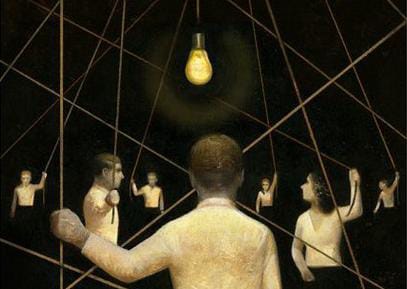Quantum game theory: A paradigm shift in Management Research
Merging the principles of quantum mechanics and game theory, the interdisciplinary field of quantum game theory has been making waves in both the scientific and game theory communities. By incorporating the bizarre properties of quantum physics into the study of strategic decision-making, quantum game theory has the potential to revolutionize various domains. In this article, we will delve into the foundations of quantum game theory, its key concepts, and the exciting possibilities it presents, with the help of very simple and easy examples.
Understanding Classical and Quantum Game Theory
Game theory was invented as the study of strategies we can use in games to get the best output. Then a bunch of physicists decided to join this field and apply quantum mechanics to it, in order to see what can happen.
But you may ask, why would anybody want to do this?
Apart from the fact that it looks cool and fun, we can actually get a better outcome in lots of cases.
First, let us discuss classical game theory at an introductory level through the classic example of “The Prisoner’s Dilemma”.
Two people – let’s call them P1 and P2 – decide to rob a bank and get caught. The police bring them in for questioning and place them in separate rooms. Now a few things can happen. You may refer to Table/Matrix 1 to better understand all possible options. Please note that the first column represents the options available to P1, i.e., stay quiet or snitch, whereas the first row represents the options available to P2, i.e., stay quiet or snitch.
- Both P1 and P2 remain quiet, and police have enough evidence to put both P1 and P2 in jail for 1 year only (1,1).
- P2 snitches on P1 and P1 stays quiet. P1 will get 5 years for the crime and for not cooperating in the investigation, whereas P2 will walk free (5,0).
- P1 snitches on P2 and P1 stays quiet. P2 will get 5 years for the crime and for not cooperating in the investigation, whereas P1 will walk free (0,5).
- Both P1 and P2 snitch on each other. Then, both will get a jail time of 3 years each for the crime (3,3).
| P1 \ P2 | Stay Calm | Snitch |
| Stay Calm | 1,1 | 0,5 |
| Snitch | 5,0 | 3,3 |
Table/Matrix 1
So now, what is the best thing to do here for P1 and P2? In terms of game theory, what is the optimal strategy?
It looks like the best thing to do for both P1 and P2 is to stick to option 1 and stay quiet (1,1).
But since both P1 and P2 are in separate rooms and cannot communicate with each other, P1 and P2 can only make decisions for themselves. That gives way to options 2-4.
3 years jail time is better than 5 years of jail, Therefore the safest thing to do for both is to snitch on each other. No matter what the other partner is doing, both P1 and P2 will be rewarded for snitching. This point (3,3) is called “Nash Equilibrium”, discovered by mathematician John Nash who was awarded the Nobel prize in Economics. “Nash Equilibrium” is a point where neither P1 or P2 has any incentive to change their decisions, because if they change their decisions, they may end up with 5 years in jail rather than 3 years in jail.
In the words of Russell Crowe who plays the character of John Nash in the Hollywood movie A Beautiful Mind (2001) – “This is the catch of an individual’s dilemma – what is best for the individual is not best for the all” (Howard 2001).
Let’s now add some flavour of quantum mechanics to game theory.
If we include some quantum rules to the Table/Matrix 1 for P1 and P2, they can do away with the catch. In other words, there can exist a guarantee that if both stay quiet, P1 and P2 cannot harm each other. Jens Eisert (1999) in his paper “Quantum Games and Quantum Strategies” outlined this perfectly.
This is how it works – both P1 and P2 are given a qubit. Now the question arises, what is a qubit?
Qubit is short for quantum bit, and bit is short for binary digit. Just think of bit as a piece of information, usually represented by 0 and 1. Classical bits can be one thing at a time – 0 or 1, whereas quantum bits or qubits can be both 0 and 1 at the same time. This may seem weird, but this is a phenomenon which appears several times in quantum mechanics, and it’s called superposition.
You may have heard the story of “Schrodinger’s Cat” – a cat which is in superposition of being both dead and alive. If a cat is considered as a qubit, then let’s assume 1 means alive and 0 means dead. A qubit can remain in a superposition state, that is, both 0 and 1 at the same time.
Another thing a qubit can do is entanglement with one another. This concept is very important, and you don’t need a degree in Physics to understand it if you stay with the example given below.
If a particle with a total spin zero decays into two spin (1/2) particles, then because of conservation of momentum, total spin needs to be conserved. In other words, if particle 1 is spinning up, i.e. (+1/2) then particle 2 will be spinning down, i.e. (-1/2).
So, you see, (+1/2) + (-1/2) = 0
Total spin after and before decay is equal to zero. I told you; it is easy to understand.
Now, if we transport particle 1 to another side of galaxy and measure the particle 2 on earth, then if particle 2 is spinning up, i.e. (+1/2), particle 1 will be instantaneously spinning down, i.e. (-1/2), faster than the speed of light. It is as if particle 1 knows the state of spinning of particle 2. This is what entanglement is.
Now let’s go back to our example involving “The Prisoner’s Dilemma” where both P1 and P2 have only two options – stay quiet and snitch. Suppose both P1 and P2 have a qubit, then they have a whole range of quantum moves. I am not going to include what these moves are because it involves a lot of mathematics. However, upon applying quantum mechanics, P1 and P2 can get something called Q moves (see Table/Matrix 2), which ensures that both P1 and P2 can stay quiet, with a guarantee that other players won’t snitch.
In other words, the presence of qubit forces cooperation. Of course, both P1 and P2 still have to go for one year jail time (1,1).
| P1 \ P2 | Stay Calm | Snitch | Q move |
| Stay Calm | 1,1 | 0,5 | 3,3 |
| Snitch | 5,0 | 3,3 | 0,5 |
| Q move | 3,3 | 5,0 | 1,1 |
Table/Matrix 2
Challenges and Future Prospects
So, beyond getting less jail time, what can quantum games be used for?
Regular classical mechanics has taught us a lot about computation. By thinking of algorithms as strategies, we can imagine their design as a game. For example, an opponent is trying to break your algorithm, and you need a strategy to make it robust. With the advent of quantum computers, there is no doubt that quantum games will help us explore the possibilities of quantum computing.
Despite its promising prospects, quantum game theory also faces several challenges. The implementation of quantum strategies requires advanced technologies and precise control over quantum systems. Additionally, understanding the effects of noise and decoherence on quantum games is essential for real-world applications.
Conclusion
A fascinating fusion of quantum mechanics and game theory, the future of quantum game theory is exciting as it offers a fresh perspective on strategic decision-making. By harnessing the power of quantum properties, such as superposition and entanglement, researchers are exploring novel approaches to various fields, including economics, cryptography, quantum communication, quantum simulation and quantum computing. The field holds true potential for creating innovative strategies and unravelling the mysteries of quantum phenomena through strategic interactions.
Afternote
In this afternote, I wish to elaborate on a small story from the movie A Beautiful Mind, wherein Russell Crowe won an Academy Award for his role as John Nash. This story will help us to understand that many scientific discoveries happen in very unusual circumstances. John Nash, a young PhD student, and his friends were trying to impress a group of girls and he suddenly discovered this great idea of securing a girl for himself and for each of his friends. It is here that we hear the famous statement – “Best result will come when everyone in a team does best for himself and for the team”. He tried to convince his friend that individually doing what is best for himself will slim down his chances with a girl, as compared to every team member doing what is best for themselves as well as other members. Before this moment, people used to believe in the theory given by the father of modern economics, Adam Smith, who believed that a group will achieve its greatest success when each member of the team does what is best for themselves. The incident with his friends helped John Nash discover this path breaking theory. In the movie, he thanked one of the girls, left her confused, and went on to his room to write and develop the theory as well as mathematics behind it. He submitted his 28-page PhD thesis the very next day. I watched this movie when I was a B.Tech student. Now I am a PhD scholar, and I am still waiting for my miracle moment which will help me discover some path breaking theory for my PhD thesis, and also perhaps help win me a Nobel Prize like John Nash.
Author: Rishav Raj
About the Author: Student of Ph.D. 03
#quantum #gametheory #theprisonersdilemma #schrodingerscat
#innovative #iimbg #theenlighteningiim
References
Eisert, J., Wilkens, M., & Lewenstein, M. (1999). Quantum games and quantum strategies. Physical Review Letters, 83(15), 3077.
[UCI Media]. (2014, August 23). Donald Hoffman – “Quantum Game Theory” [Video]. Youtube. https://www.youtube.com/watch?v=iPtztfGuIGk
[Aditya Jagannatham]. (2014, December 5). Strategy: An Introduction to Game Theory [Video]. Youtube. https://www.youtube.com/watch?v=OKHiS0xDBb4&list=PLDlJ2nw7-dHb3oowMJfwgleor6dwWsVZ1
[Up and Atom]. (2018, March 22). The Quantum Prisoner’s Dilemma (ft. Physics Girl!) [Video]. Youtube. https://www.youtube.com/watch?v=_kLb1glm6EM&t=185s
Howard, R. (Director). (2001). A Beautiful Mind [Film]. DreamWorks Pictures.


